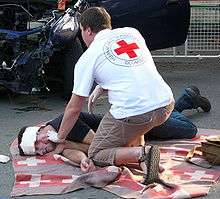First Aid/Shock
< First AidIntroduction — Issues in Providing Care — Primary Assessment & Basic Life Support — Secondary Assessment — Circulatory Emergencies
Respiratory Emergencies — Soft Tissue Injuries — Bone & Joint Injuries — Environmental Illness & Injury
Medical Conditions & Poisoning — Advanced Topics — Appendices — Meta content
Introduction
Shock can refer to a range of related medical conditions in which the victim's heart, lungs and blood cannot deliver oxygen to the body properly. Shock is not a diagnosis or condition, it is always a symptom of a larger problem, and is a medical emergency that requires immediate attention. One should never confuse true shock with a feeling of extreme surprise - one does not lead to the other.
Key types of shock
- Hypovolemic shock - Caused by the rapid loss of blood from the blood vessels, either inside and outside the body.
- Cardiogenic shock - Caused by failure of the heart to move blood adequately. This is typically caused by damaged heart muscle due to a heart attack.
- Distributive shock - Caused by enlargement of the blood vessels so that the pressure within them drops.
- Anaphylactic shock - Caused by an allergic reaction which forces fluid out of the blood vessels
- Septic shock - Caused by a severe infection which poisons the blood vessels, causing them to enlarge
- Neurogenic shock - Caused by a spinal cord injury, preventing the brain from communicating with blood vessels
- Obstructive shock - Caused by a blockage in a blood vessel, preventing blood from flowing past it.
Regardless of type, the goals of the layperson rescuer are the same: prevent blood loss and preserve body temperature.
Recognition
The sooner that shock is recognized, the better the victim's outcome will be. Although signs of shock can range greatly, some common signs are:
- Early Phases
- A fast pulse
- Pale, cool, clammy skin
- Sweating
- Flushed face
- Anxiety or agitation
- Developing phase
- Ashen or blue skin on lips and nail beds
- Cold, damp skin
- Weakness and dizziness
- Nausea and possibly vomiting
- Thirst
- Rapid, shallow breathing
- Weak, very rapid, "thready" pulse
- Confusion, disorientation
- Advanced phases
- Lack of pulse in wrists or feet
- Restlessness and aggressiveness
- Yawning and gasping for air
- Unconsciousness
- Final phase
- Multiple organ failure
- Cardiac arrest
Treatment

The most important treatment for shock of any variety is to try and maintain the blood flow to the body's vital organs (brain, heart, and lungs). To do this, lie the patient flat on the floor and raise their legs about 6-12 inches (15-30cm) off the ground. Do not incline the victim's head, chest, or pelvis, as this brings no improvement and can cause harm.
Other important factors in the treatment of shock can be remembered by the simple mnemonic WART:
- Warmth
- ABCs (Airway, Breathing, Circulation.)
- Rest & Reassurance
- Treatment of underlying cause
Unconscious patients
Should a patient become unconscious, confirm that an ambulance has been called, and take the following steps:
- Reassess the ABCs. Should any change occur, compensate with required treatment. (ex. Patient goes into cardiac arrest, begin CPR.)
- As airway takes priority over other treatment, you should place them in the recovery position in order to ensure a patent airway.